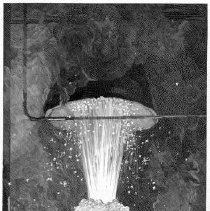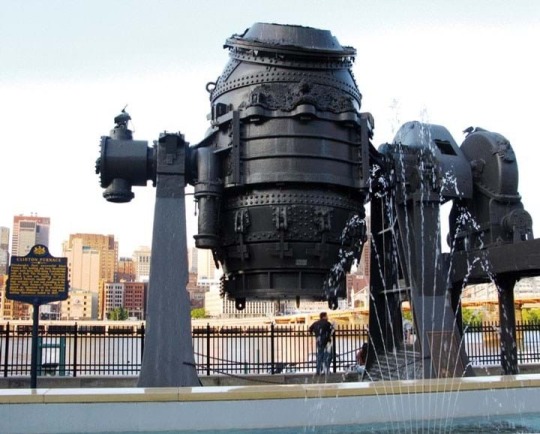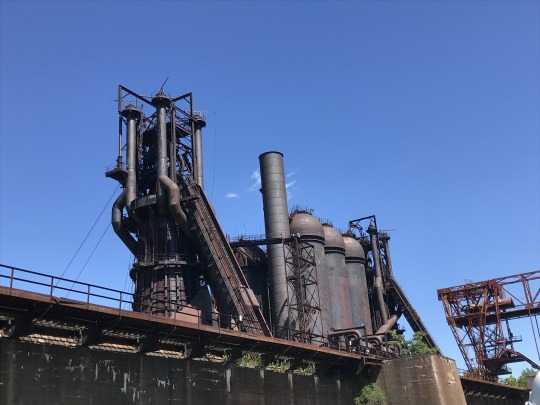#i spent a while on this i deserve to maintag it
Text
After reading this thread and the ongoing discourse of Iron vs Fires vs Stones in the railway steel trade, I had more thoughts I wanted to share about the industry, but I didn’t want the reblog chain to get too long so here we are (Also tumblr ate my first draft of this rip). I’m from Pittsburgh, Pennsylvania, US, which has a rich history of the steel industry, and I finally get a relevant opportunity to infodump. This post will dive into a little more detail about the layers of steel production and where specific contention points between the Masters would be.
As mentioned in the thread, the Bessemer process involves blowing oxygen into the furnace to remove impurities from molten pig iron, thus producing steel. Pig iron is produced after iron ore is smelted in a blast furnace, making it higher in carbon. Blast furnaces are fueled by coke, a processed form of coal. A flowchart of the basic steps from start to finish, with products in gray and locations in red:

Now, I would be remiss if I didn’t share some visuals. A Bessemer Steel Converter, 1889, Rivers of Steel Archives. Source

Not the same one as in the picture, but there is still a Bessemer steel converter standing as a historic landmark in Station Square in Pittsburgh.

Also still standing as a historical landmark, a little outside the city, is the Carrie Blast Furnace. My own photo from when @thedeafprophet and I toured. (No, we didn’t sign up for a tour specifically because we were thinking of the Masters, don’t be silly. It was only partially because of the Masters and more for special interest in history and engineering.)

And a photo Prophet took:

Carrie is big and she is beautiful. Now, I know we’re talking about Fallen London, and the UK is very different in history than the US, but I can’t bring up Carrie without suggesting further reading on the Battle of Homestead, which occurred in 1892 after long years of tension between the Carnegie Steel Company and the Amalgamated Association of Iron and Steel Workers. As you can imagine, the company favored increased productivity, longer shifts, and lowered wages. Pinkerton guards were called in to break the strike, and a battle in the early morning ensued which the union actually won, forcing the strikebreakers out by railroad. Unfortunately the union did lose the war, and there wasn’t a significant steelworkers union in the United States until the 1930s. Later, the merger of some companies including Carnegie Steel formed US Steel, which was the first billion dollar company in the country.
The Gilded Age. Yay.
Now that we’ve gone into some detail about the components of the steel process and a small tangent on labor history, the question of which master has its claws in which part of the steel industry comes up. I’ve created this visual aid for the points of contention:

Fires: claim to fuel and the forge. Stones: claim to all that comes from the ground. Iron: claim to metal. The discourse between the three is funny, yes. But really, what difference is there when they’re all cartoon industrialist villains who want productivity and profit above all else! (I cannot overstate how evil real companies in the era were, Carnegie Steel being only one example. The Masters are not an exaggeration except for the fact they're literally monsters lol)
Now, from my own experience, a ton of space is required to sustain an active steel industry for a nation that is building railroads, buildings, weapons, etc. I don’t think Fallen London has that space. Satellite sites exist in the Neath (I have not played much Sunless Sea but I’m aware of the existence of the Iron & Misery Company) but even then it isn’t much. There must be places to mine, places to process coke, places for blast furnaces and places for mills. Molten pig iron must be transported in special train cars between furnace and mill. Quite simply, machines take up space. It makes reasonable sense for the majority of steel to be imported in London. I don’t doubt London is capable of producing some steel, but not the quantities required to sustain an industrializing country.
Once again tangential, but I find it amusing that the Enthusiast of the Ancient World is the one who trades steel at the bone market, and here in Pittsburgh, the natural history museum is named for Carnegie, after he poured money into philanthropy to try to save face after the Homestead Strike. Imagine a museum full of bone market creachures.
But to end on a serious note, the steel industry is dangerous and dirty. Workers up close with molten metal, risking life and limb (and workers in the era of Fallen London having little safety regulations). Use your imagination. Despite the industry’s decline in this region in the 70s and 80s with companies outsourcing labor, there are still active works here. My parents tell me stories about growing up with soot everywhere and the air smelling like sulfur. Today, the air quality is much improved but leaves something to be desired. There is a balance somewhere between heritage, the environment, and employment, and I don’t have the answer to that. Anyway, I wrote this post in my head while driving past some of the works today
#infodump time with R#i spent a while on this i deserve to maintag it#fallen london#i spent entirely too long on this lol but I had fun#obligatory remark I'm by no means an expert in this I just listen to a lot of lectures
36 notes
·
View notes